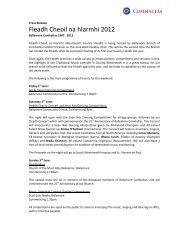Free Guide - Discover Ireland
Free Guide - Discover Ireland
Free Guide - Discover Ireland
You also want an ePaper? Increase the reach of your titles
YUMPU automatically turns print PDFs into web optimized ePapers that Google loves.
Mellifont Abbey<br />
Mellifont Abbey was one of the wealthiest<br />
and most influential monastic houses in<br />
medieval <strong>Ireland</strong><br />
Mellifont Abbey is situated in a tranquil valley on the banks of the<br />
River Mattock, a tributary of the River Boyne. The Abbey derives<br />
its name from the Latin Font Mellis meaning ‘fountain of honey’.<br />
Many medieval monasteries founded by continental orders bore<br />
Latin names. Mellifont is the only one that survives as a current<br />
placename in <strong>Ireland</strong>.<br />
St. Malachy, Archbishop of Armagh, along<br />
with a community of Irish and French monks<br />
(trained at Clairvaux, Burgundy), founded<br />
Mellifont Abbey in 1142 on lands granted<br />
by Donogh O’Carroll, King of Oriel. It was<br />
the first Cistercian monastery established in<br />
<strong>Ireland</strong> and over 20 other Cistercian houses<br />
were founded directly or indirectly from it.<br />
Mellifont also became one of the wealthiest<br />
abbeys in <strong>Ireland</strong> with vast holdings of land<br />
in the fertile Boyne Valley.<br />
The Abbey was consecrated in 1157 amidst<br />
great ceremony at a national synod, which<br />
was attended by the leading clergy of the<br />
time and Murtaugh MacLochlainn, the<br />
16 FOR MORE INFORMATION GO TO WWW.DISCOVERIRELAND.IE/BOYNEVALLEY<br />
High King of <strong>Ireland</strong>. Mellifont heralded<br />
a new era in Irish monasticism. Prior to<br />
its foundation, older Irish monasteries<br />
(such as Monasterboice) were essentially<br />
independent self-governed spiritual centres,<br />
under the direction of an Abbott who was<br />
largely his own master. These older monastic<br />
sites were often not affiliated to any other<br />
monastery or even to any religious order.<br />
Mellifont was dissolved in 1539 and passed<br />
into the hands of Sir Edward Moore who<br />
converted the abbey buildings into a<br />
residence. In 1603, following Irish defeat<br />
at the Battle of Kinsale, Hugh O’ Neill, the<br />
Earl of Tyrone, formally submitted to Lord

















